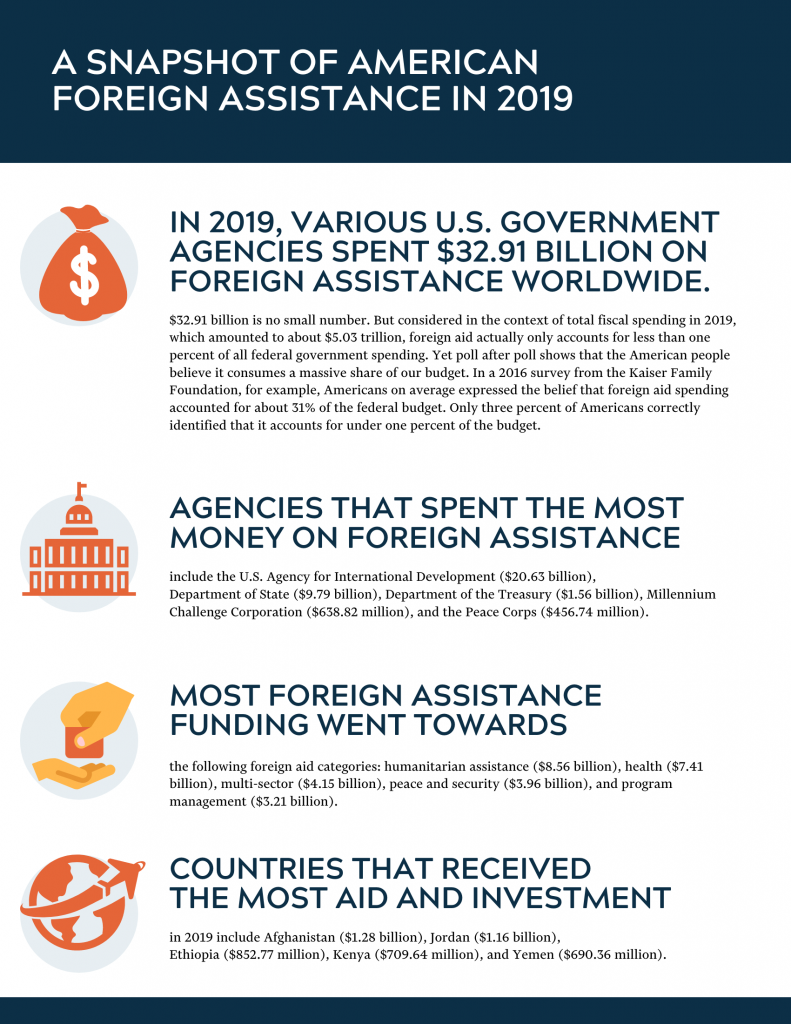U.S. Foreign Aid Policy in the Age of COVID-19

In April 2020, the Trump Administration halted funding for the World Health Organization (WHO), an agency of the United Nations, while it reviewed the agency’s response to the COVID-19 pandemic. One month later, President Trump announced that the U.S. would officially withdraw from the WHO, and in July the U.S. initiated a formal withdrawal. Because the WHO requires a one-year notification and all debts paid for a withdrawal process to be completed, the U.S. will not officially cease being a member until July 2021.
The U.S. withdrawal notification was the culmination of months of mounting tensions between the Trump administration and the WHO, which the administration accused of failing to disclose timely COVID-19 case data and mortality information, providing faulty theories on transmission mechanisms, opposing travel restrictions, and accepting at face value inaccurate statements made by the Chinese government early into the pandemic.
The Trump administration’s swift decision to cut ties and funding to the World Health Organization was criticized by Democrats and Republicans. Senator Lamar Alexander (R-TN), the Chairman of the Senate Health Committee, said that “certainly there needs to be a good, hard look at mistakes the World Health Organization might have made in connection with coronavirus, but the time to do that is after the crisis has been dealt with, not in the middle of it.” And on Twitter, House Speaker Nancy Pelosi (D-CA) said that “with millions of lives at risk, the President is crippling the international effort to defeat the virus.”
| How Does a U.S. Withdrawal Affect the World Health Organization’s Revenue? According to the Congressional Research Service, U.S. contributions to the United Nations and its various agencies, including the World Health Organization, are not technically “foreign assistance” because they are dues to multilateral organizations. But the United States contributed about $10 billion to the United Nations in 2018, making it the largest contributor to the system as it accounts for about 17% of total revenue collected from all member states. While the U.S. is not threatening to withdraw from the United Nations itself, it has begun the official withdrawal process from the WHO. Should the U.S. withdraw in 2021, the WHO stands to lose $407.5 million in assessed and voluntary contributions from the United States—14% of its total budget. |
Yet, the decision to withdraw is consistent with the Trump administration’s skepticism of the need and efficacy of foreign aid. But are they right to be skeptical? This New Center issue brief seeks to provide a primer on U.S. foreign aid policy, what the public thinks of it, and what role it should play in our relations with the world now and in the future.
U.S. Foreign Aid Policy: A Primer
Most U.S. foreign aid is delivered through authority created under the Foreign Assistance Act of 1961. When signing the FAA into law, President John F. Kennedy remarked that “the long-term commitment of development funds, which the bill authorizes, will assist the under-developed countries of the world to take the critical steps essential to economic and social progress.”
Since that time, other legislation has been enacted that both amends and adjusts the original Foreign Assistance Act. This includes the Arms Export Control Act, International Security Assistance Act, and the International Finance Corporation Act, among many others.
The Foreign Assistance Act and accompanying bills authorize over 20 U.S. government agencies to disperse aid funds. Agencies with the highest portions of obligated aid dollars include the U.S. Agency for International Development (USAID), various military agencies and armed services, the Department of State, Department of Health and Human Services, and the Millenium Challenge Corporation.
ForeignAssistance.gov divides foreign assistance into the following categories:
- Environment
- Humanitarian assistance
- Program management
- Multi-sector (meaning it cross-cuts several categories)
- Peace and security
- Democracy, human rights, and governance
- Health
- Education and social services
- Economic development
According to the Congressional Research Service, today’s foreign aid is primarily in the form of grants as opposed to loans (by FY2001, loans accounted for under one percent of total aid appropriations), which is done “so as not to increase the heavy debt burden carried by many developing countries.”

Sources: ForeignAssistance.gov, USASpending.gov, Kaiser Family Foundation
Is Foreign Aid Actually Effective?
Despite the fact that foreign aid makes up less than one percent of federal spending, much of the American public still believes the U.S. should cut back its spending abroad. In a 2017 Chicago Council Survey, when asked what federal government spending should be expanded, cut back, or kept about the same, about 50% of Americans believed that military and economic aid to other nations should be cut back while domestic social security, education, healthcare, and defense spending should be expanded.
Americans have a right to be skeptical of where and how their taxpayer dollars are spent, and this is especially true of U.S. contributions to the United Nations, an organization which has faced long-standing criticism over its effectiveness.
A prime example of this is the United Nations Human Rights Council (UNHRC), whose membership has in the past consisted of flagrant human rights violators like Saudi Arabia who in turn used the council to advance their own agenda against other countries. For example, The Conversation notes that “there have been more special sessions convened on Israel than any other country, even Syria. And in total, Israel has received more of the council’s attention than the Democratic Republic of Congo (where millions of people have been killed or displaced in recent years), Darfur and Sri Lanka (where genocides were perpetrated), North Korea, and Yemen. And this is not just more than each of those countries—but more than all of them combined.”
High-profile cases like the UNHRC might mar the public’s perception on the effectiveness of foreign assistance and contributions to international organizations. But foreign aid has historically provided tremendous benefits—not just to the recipients—but to America’s economic and national security.
In 2014, USAID (in partnership with the Latin American Public Opinion Project and Vanderbilt University) released a report on the impact of USAID’s community-based crime and violence prevention approach in Central America. Central American countries in the Northern Triangle region, which include Guatemala, El Salvador, and Honduras, are considered some of the most dangerous nations in the world. The report found that “USAID’s crime prevention programs in Central America have been a success. The outcomes in the treatment communities improved more (or declined less) than they would have if USAID’s programs had not been administered.” Specific outcomes include a 51% decline in reported murders, a 51% decline in reported extortion, a 35% decline in ‘reports of avoiding walking through dangerous areas,’ and a 25% decline in reported sales of illegal drugs.
U.S. foreign aid stretches far beyond crime prevention in the Americas to tackle food insecurity, health disparities, and education gaps. The results of U.S. involvement in the aforementioned areas are included in the USAID Investing in Our Shared Future report from 2017:
- Feed the Future, founded in 2010, is the U.S. government’s global food security initiative. In areas where Feed the Future operates, extreme poverty dropped between seven percent and 36%, and participating countries have increased domestic spending on agriculture by 85% on average between 2009 and 2014.
- Between 2010 and 2017, USAID’s efforts in global health reduced preventable child and maternal deaths by 4.6 million and 200,000, respectively.
- USAID’s education initiatives have provided 150 million textbooks to children and repaired 11,000 classrooms since 2011 to assist in improving learning outcomes.
These benefits to foreign countries provide direct economic and security benefits to the United States. According to a 2018 USAID report, “over the past 10 years, almost two-thirds of the growth in U.S. goods exports was to major USAID partners. This strong export growth was critical to pulling the U.S. out of the most recent [2008-2009] recession.” And in 2013, former U.S. Defense Secretary James Mattis, testifying before Congress, explained why investments in diplomacy and foreign aid are so crucial. He said:
“If you don’t fund the State Department fully, then I need to buy more ammunition ultimately. It’s a cost-benefit ratio. The more that we put into the State Department’s diplomacy, hopefully the less we have to put into a military budget.”
Given the immense benefit to U.S. national security, foreign aid shouldn’t be viewed as a luxury cost to shed, but an essential investment to keep America safe.
